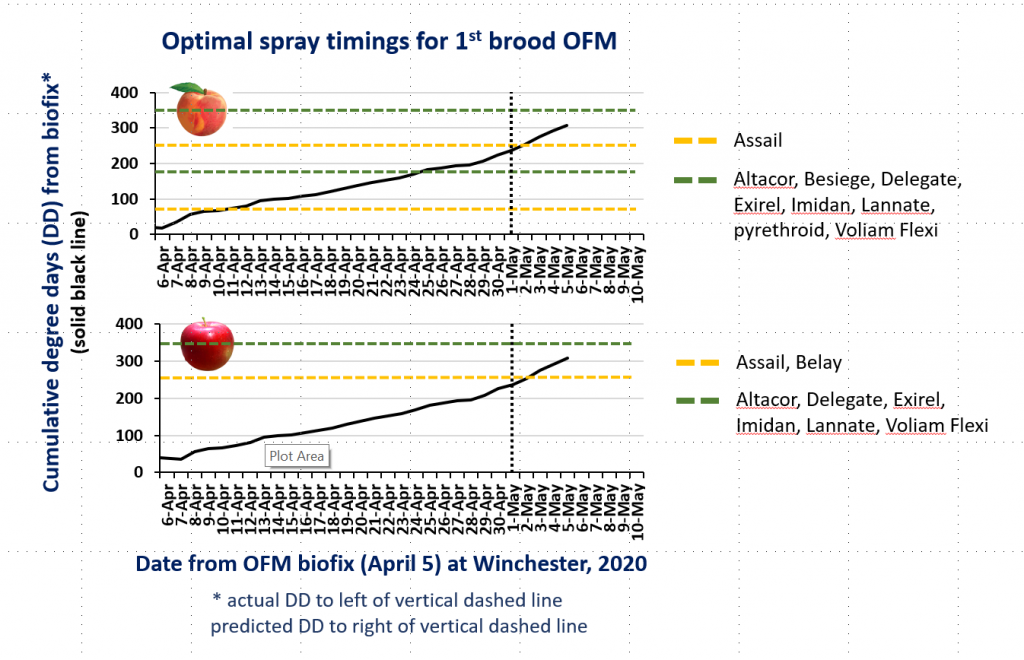No codling moth captures at the Winchester AREC as of April 30; same observation reported from others with codling moth traps deployed.

Greetings, This year I’m going to try a new way to present degree day (DD) accumulations from biofix and optimal spray timing recommendations for various insecticides for OFM and codling moth (CM). As I noted last week, OFM biofix was set at Winchester on April 5. The solid black line in the graphs below shows how many DD already have and are predicted to accumulate for OFM since biofix (see footnote). The colored horizontal lines are recommended optimal timings for the color-coded products shown to the right of the graphs. These recommended optimal timings are based on the relationship between DD accumulations and the percentage of eggs of each brood that have hatched (here the 1st brood of OFM). Note that recommended timings amd number of sprays for 1st brood OFM differ between apple and peach. The vertical dashed black line separates actual DD accumulations (to left of line) and 5-day predicted accumulations (to right of line), based on output from Cornell’s NEWA system using temperature data from the weather station at the Winchester AREC. When the solid black line crosses one of the colored lines, the date on the horizontal axis below is the optimal date to apply the product corresponding to that color. So, for Assail in peaches, the best timing would have been April 12th or 13th. As the solid black line approaches the intersection with one of the colored lines, this will give you advanced notice that an optimal spray timing is approaching. Of course, the decision to apply an insecticide can also be informed by moth captures in pheromone traps. For 1st brood OFM in peaches the threshold is an average of more than 15 moths/trap/week and in apples is more than 30 moths/trap/week. Once we are into 2nd brood OFM, the threshold is more than 10 moths/trap/week for both crops. We have not captured CM in our traps at the AREC, but will include a similar graph for it once biofix has been set.

I’m calling biofix for OFM in the Winchester area for Sunday, April 5, based on sustained captures since then, although at relatively low levels. We will soon begin to post regular updates regarding degree day accumulations from OFM biofix and spray timing/product selection implications on my section of the website at https://blogs.ext.vt.edu/tree-fruit-pest/. If you plan to use mating disruption for OFM, now would be a good time. Recall that OFM is one of the species that shows “protandry”, which means that males emerge before females. The degree day models that we run are to predict egg hatch; therefore, females need to be present for mating and egg-laying to occur. Given the cool and windy conditions forecast for many of the next 10 days, I don’t expect a heavy , sustained flight of OFM until the weather improves. The sprayable formulation for OFM (CheckMate OFM-F) is a good choice for managing first generation OFM and to mitigate its populations from increasing during the season. This product is applied at 1.32 – 2.93 fl oz/acre, but is not especially rainfast, so may need to be reapplied to cover the flight of the entire first generation if heavy rain occurs after application. Sprayable pheromone is intended to be applied against each generation of OFM. Other options for OFM mating disruption include a number of hand-placed pheromone dispensers from Trece (Cidetrak products; trece.com/products/) and Pacific Biocontrol (Isomate products; pacificbiocontrol.com/details/), which provide extended control. Both companies also provide dual species mating disruption dispensers for codling moth and OFM, which are typically applied in apples during bloom. Of course peaches are now at petal fall, and so also need protection from a number of other pests from this point forward, including plum curculio, tarnished plant bug, and stink bugs, among others. In the Spray Bulletin, we recommend a broad spectrum pesticide at petal fall, including one of the pyrethroids, Lannate, or Imidan. Follow-up applications at shuck split and shuck fall could also include a pyrethroid, or a range of others listed in the Bulletin, according to which pest(s) were most problematic last year (i.e. some of the products listed for shuck split and shuck fall are narrower in their spectrum of activity).
Greetings, For our weekly meetings via Zoom (Tuesdays starting at 12 PM) we would like to invite you to submit digital photos of things you are seeing in your orchards this year that you have questions about. Along with our updates, we could discuss these pictures together and try to provide relevant feedback and recommendations. This could include pictures of disease, insects or insect injury, or horticultural issues. It would be very useful if you would also send us photos of the stage of fruit bud development in your area. When you submit photos of any issues you are seeing (i.e. other than stage of bud development), please include any pertinent information and your specific question(s). We will keep these photos anonymous, but read your question/comments about each image to the group. Of course, sharp and clear images will work best for this, and it would be ideal to receive them by about 11 AM on Tuesday. You can send these as attachments to any or all of us at the following addresses: cbergh@vt.edu, ssherif@vt.edu, ksyoder@vt.edu, or mastuph2@vt.edu. Looking forward to meeting with you again this Tuesday.